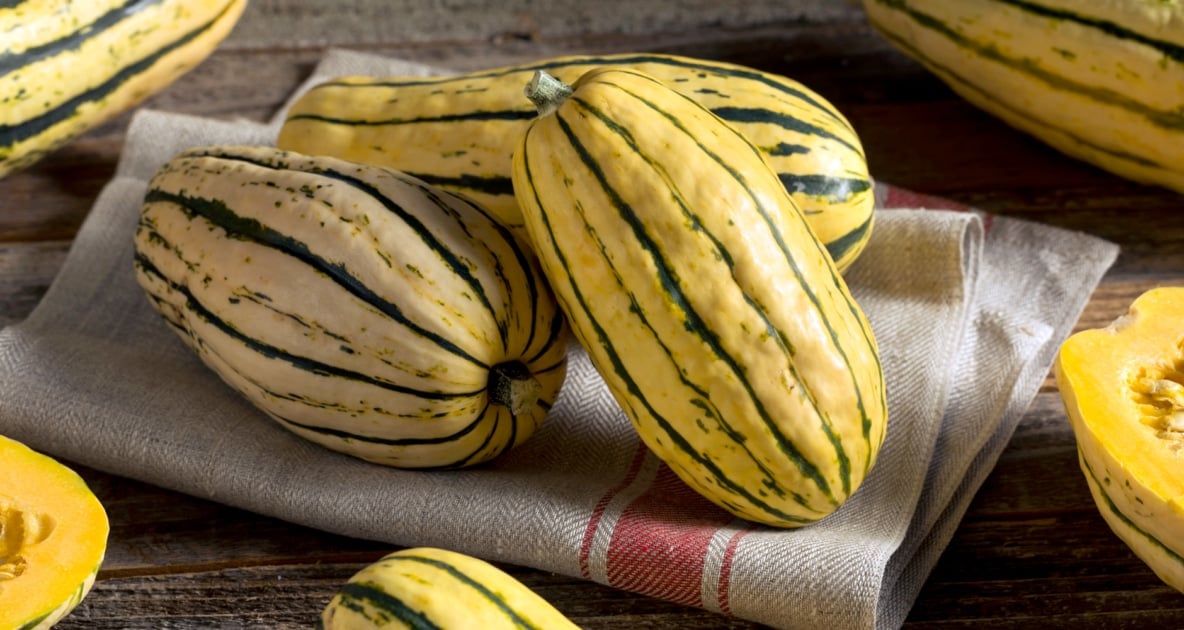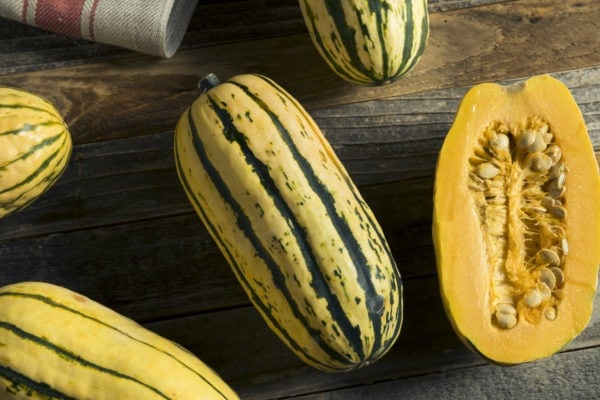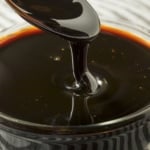What The Heck Is Delicata Squash?
What is this pinstriped squash and how is it prepared? Discover why delicata squash is gaining in popularity, and try this simple, yummy recipe!

The latest variety of winter squash that’s booming in popularity is delicata. You may have seen this butter-colored pinstriped squash popping up around the pumpkins and gourds at the market this season and wondered, what the heck is it? Is it ornamental or edible? Delicata squash (Cucurbita pepo)—also known as peanut squash, Bohemian squash, or sweet potato squash—is favored for its delicate, edible skin. No peeling required! So if you love the taste of butternut squash but don’t like the hassle of peeling that hard, impossible rind, delicata squash may be your new favorite.
Although it’s considered a winter squash, it is in the same family as yellow summer squash and zucchini.
But even if it requires no peeling, it has to be tasty, right? Delicata is not only attractive on your harvest table but it’s so delicious as well. The creamy yellow flesh is wonderfully sweet, so you don’t need to add much to enjoy it. And it’s incredibly versatile—it can be stuffed and baked, steamed, oven roasted, microwaved, or sautéed. To prepare, slice it in half, and scoop out the seeds (which can be roasted just like pumpkin seeds).
Why The Sudden Popularity of Delicata?
Seeds for growing this variety have been available in the U.S. since the 1890s so why haven’t we heard of this squash before? Delicata squash was highly prone to mildew diseases, and after the Great Depression, this variety seemed to be nonexistent. In the early 2000s, Cornell University’s Department of Plant Breeding* bred an open-pollinated, non-hybrid variety resistant to typical squash diseases, and their results provided commercial food growers and markets with a hearty cultivar.
Delicata Squash Health Benefits
Not only is delicata squash pretty to look at, but it’s also nutritious. It’s a good source of potassium and dietary fiber, and contains magnesium, manganese, and vitamins C and B. But unlike most winter squash varieties, this squash is not as rich in beta-carotene.
Growing Your Own Delicata Squash
Delicata squash is typically grown in the summer season and harvested in the fall. With the modern disease-resistant cultivar, growing your own from seed is easy. Plant seeds outdoors after the last threat of frost has passed. Plant up to six seeds, one inch deep, in a small mound of garden soil. The squash is ready to harvest 100+ days after germinating. After picking, the squash must be cured for a week or two in a warm, dry place before use.
Storing Delicata Squash
Delicata squash has a shorter storage life than other winter squashes; it can be stored up to three months in a cool, dry place. Avoid refrigeration.
Roasted Delicata Squash Recipe
Ingredients:
- 1 delicata squash, any size
- Coconut oil or olive oil spray
- Sea salt and pepper
Instructions:
- Wash squash and dry the squash. Halve the squash lengthwise and remove seeds with a spoon (save them for roasting!). Cut into ¼-inch-thick slices (no need to peel) using a mandolin or a large, sharp chef knife. Variation: You can also cut the squash in half crosswise, scoop out the seeds from each half, then cut into rings to preserve the circle shape. Note: The thinner you slice the squash, the crispier the rings will be.
- Place rings in a single layer on a lined cookie sheet. Spray rings with oil and sprinkle with sea salt and pepper.
- Broil on low until golden brown freckles appear. Flip over and let cook until golden brown freckles appear. Remove and serve immediately.
Have you seen delicata squash in your local markets? Give it a try and let us know how you prepared it.
*Do not confuse plant breeding with genetic engineering. This article explains the difference.

Deborah Tukua
Deborah Tukua is a natural living, healthy lifestyle writer and author of 7 non-fiction books, including Pearls of Garden Wisdom: Time-Saving Tips and Techniques from a Country Home, Pearls of Country Wisdom: Hints from a Small Town on Keeping Garden and Home, and Naturally Sweet Blender Treats. Tukua has been a writer for the Farmers' Almanac since 2004.













The squash was delicious.
Delicata is technically a summer squash though it is classified as a winter squash because of its thick skin and fall readiness. Though I have gotten it fresh grown in the summer.
So I cut in half lengthways and deseed Bake until soft scoop out some meat and whip up like mashed potato put it back in the shell and broil. Just like double baked potatoes.
I just bought one last evening. I had never seen one, but I prepared it by cutting it into rings and tossing it with olive oil and salt and pepper. It was delicious. I left the skin on and probably next time will bake the halves instead of cutting into rings.
Hi Everyone, why fret about peeling the skin and removing the seeds on any large squash. Just wash the outer skin of the squash. Poke a few slits with a knife on top and sides of the squash for air escape. Put in any baking dish with some water and bake at 350o for about 45-60 min or until done. When done, slice it anyway you like. The seeds and membranes will come out very easily. Put any herb, spice or combo & butter on. The meat of the squash should separate from the skin very easily. Enjoy!
Hi! Thank you so much for the tremendous amount of information about this particular squash. I’ve never eaten the peeling (or skin) of the squash but I certainly will now. I love butternut squash but I don’t have the physical ability to peel that rind. Now that I’ve read all this info about the squash plus the recipes, it’s given me the perfect alternative. Happy Thanksgiving to all!
I never remove peel of squash. Just wash, remove seeds, cut in 1/2“ circles and bake. Delicious. Leftovers, just pop in freezer bag & freeze.
I’ve saved a recipe using Delicata squash and Kabocha, and if I ever find both of these in my local market at the same time, I will make “Winter Squash Agrodolce”. Fresno chiles, red pepper flakes and honey are also in this dish, so can’t wait to make it.
Patricia, wonderful! That sounds so interesting! Take pictures and share with us!